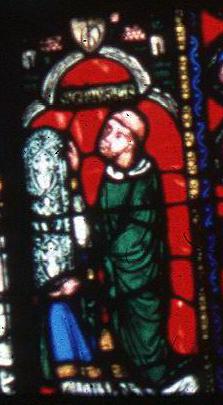 Stained Glass at St Denis
- This nice site shows six full windows from the
ambulatory, and some details. All date to c.1140, and Abbot Suger of St
Denis (portrait, right) wrote about them in detail. The site gives you
his comments. You can enlarge the full windows. Don't wait for them to
load, but scroll down for the reconstruction diagrams with their
enlargements. Note that almost all the red streaked glass is modern.
Click also on the links to full screen size. Or click on
the "archive" link for good enlarged images.
Stained Glass at St Denis
- This nice site shows six full windows from the
ambulatory, and some details. All date to c.1140, and Abbot Suger of St
Denis (portrait, right) wrote about them in detail. The site gives you
his comments. You can enlarge the full windows. Don't wait for them to
load, but scroll down for the reconstruction diagrams with their
enlargements. Note that almost all the red streaked glass is modern.
Click also on the links to full screen size. Or click on
the "archive" link for good enlarged images.
- here is a link to a gorgeous enlargement of the detail on the right. And here is a rather nice one that has found its way into the Glencairn Museum, Pennsylvania.
|


![]()

![]()